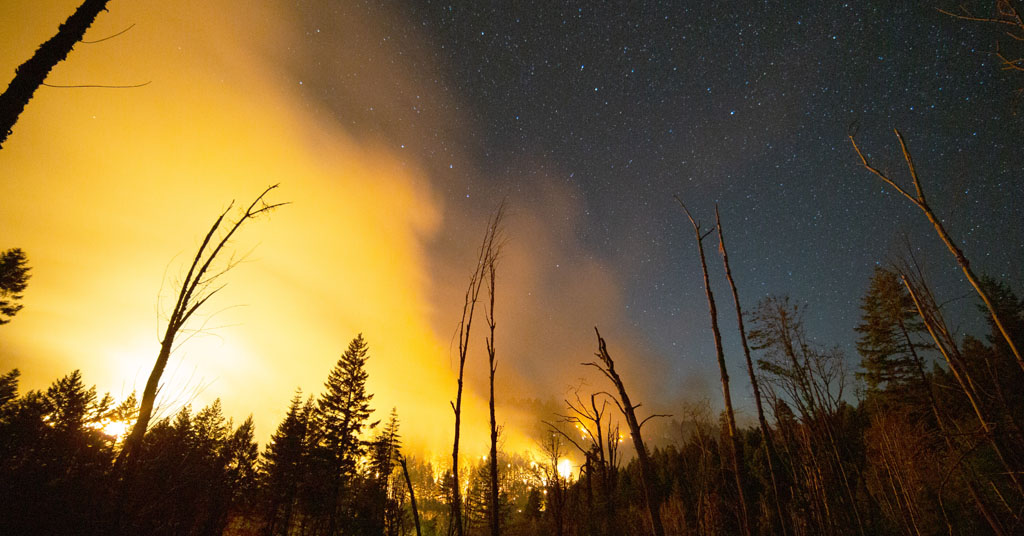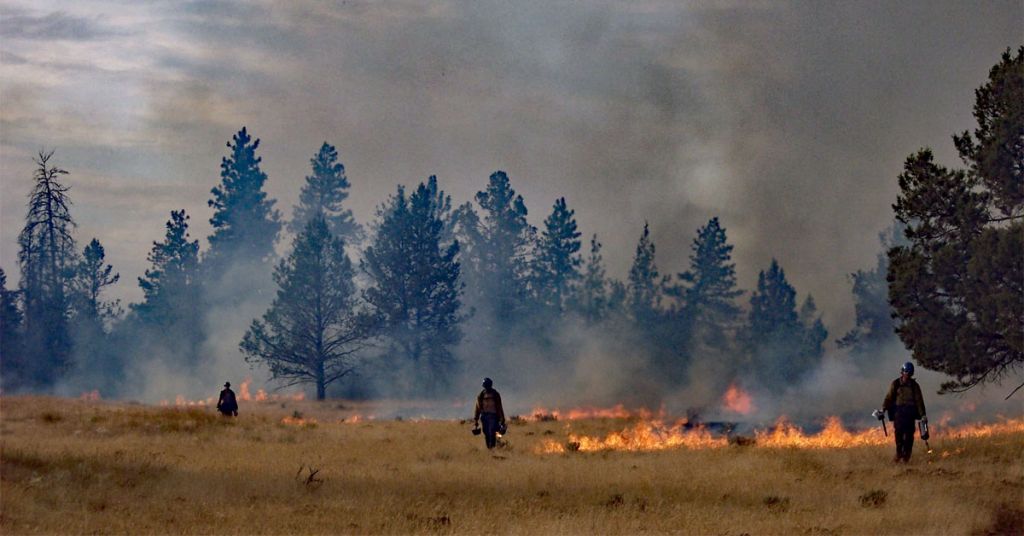The fires are more than air pollution, more than lost logging and grazing. But for now the focus must be on the urgency to somehow contain the unprecedented acreage burning in Oregon and Washington.
I wonder what I will find when I can once again hike to Bird Creek Meadows. Just a month ago, a group of us drove to Bird Lake and hiked the Crooked Creek Trail. The trail followed meandering streams so clear we could see every rock of the stream beds. The trail turned a corner and through the conifers would be a waterfall. We paused just to enjoy the beauty. Wildflowers grew thick on stream sides. Just past one waterfall the trail went through a half acre of Indian paintbrush—glorious in shades of red and orange.
Above the Round the Mountain Trail, we walked over glacier-grooved rock through Bird Creek Meadow full of blue gentian, pink monkey flowers, and purple lupines. We rested at Hell Roaring Overlook, the glacier carved valley. Above it, we looked up to snow topped Mt. Adams.
We turned around there and wandered down through forests thick with firs, pine and spruce. Huckleberries and bear grass grew below the trees
This six mile loop is one of thousands that fires have burned this summer. They are places where we go to hike, ski, and to just be in that beauty, breath mountain air, smell sunshine on pine needles.
I will miss that place, my place—a place thousands felt was their special place. It’s seems almost petty to grieve the loss of a place where we went only to recreate, when so many have lost homes and jobs. But recreation doesn’t really describe the importance of those wild places.
We need these places for in the vastness of our country, wild mountain areas are few. Deserts, wonderful in their own way, claim perhaps a third of the land. Agriculture, logging, and urban areas—concentrated and scattered—have reduced the amount of once untrammeled wild that seemed unending.
Like the loss of place, the effect of the fires on wildlife and domestic animals is little reported. So much is on our human concerns—homes burned or threatened. But we know such vast fires are destroying the habitat—the homes—of deer, elk, birds, horses and cattle.
Neil Kayser grazes cattle on Mt. Adams. As soon as the Cougar Creek Fire started, he and his ranch hands began searching the mountain to get the cattle out of danger. But even that early, some were already maimed. Their pain hurts us, too.
The smoke clogged air the last weeks created a pall to match our sadness of all the losses.
After the fires end, the trees will be a forest of blackened boles, the ground a sea of grey ash. There will be new growth springing up in the newly released nitrogen, but the sheltering forest we knew will only be there for generations far from now.











I have been thinking about Birdcreek Meadows with such sadness. I had planned an outing their three days after the fire first exploded. It was to share this special wilderness place with our daughter for the first time as she wanted to hike it and experience all the beauty it held.
Thank you for writing this story and sharing your thoughts, you express it so well. These wildfires are fueled with such mixed emotions.
I hope you find another place as meaningful Whenever you get to Bird Creek Meadows after this is all over, let us know about what you see and your experience there.
My father began taking my brother and I up to Bird Creek Meadows over 30 years ago. We went nearly every summer, and as the years went on our little three person group grew into many as my dad LOVED to share the beauty of this Mountain. He passed away 12 years ago, and we continued to go, for about 4-5 days with friends and family, almost like a beautiful yearly memorial. Each year, Saturday morning we would have a scrumptious Huckleberry pancake breakfast followed by Hiking from Bird Creek up through Bluff Lake to Hells Roaring, onto the shale ridge(Whale Back) to the Glacier Lake where the water is the most brilliant blue/green I have ever seen,continuing on to Base Camp. All the while making stops to soak up the beauty and tranquility of it all. The old growth and new growth. The tall trees and dwarf trees, the small fragrant bushes, and the bright desert paint brush, and taking pictures of the views, and the waterfalls. On the way back down we would hook into the Round the Mountain Trail somewhere near the Frog Pond and finally the back side of Bird Lake and back to our camp ground. Just one of many adventures we would take and share with others. This Mountain is my absolute favorite place on earth. It is filled with wonderful memories. It is my happy place. When I saw the post Cougar Fire pictures yesterday I was devastated. I feel as though a piece of me has died. I grieve for that gorgeous Mountain,and all who live there.My family and friends and I will be going up to help replant when we get the OK from the Rangers. It was nice to see your piece on this, I share in your feelings of loss. Thank you for the opportunity comment.